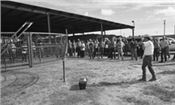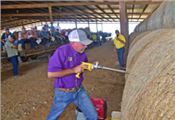|
Feeding Quality Hay Can Reduce Waste
MANGHAM, LA.
Cattle producers can limit the amount of time cattle feed on hay without any negative effects if the hay has good nutritional quality, an LSU AgCenter forage specialist said at an AgCenter beef and forage field day on Sept. 19.
Wink Alison said cattle waste as much as 50 percent of hay if it’s placed on the ground without controlling for trampling. He recommended using a hay rack to reduce damage and said using cone racks result in less waste.
Studies have shown that cattle with feeding time limited to five to seven hours perform as well as cattle that have unlimited feeding time, but good quality hay is essential for limited feeding, he said.
A 1,300-pound cow will eat about 20 pounds of hay in seven hours, about 8 pounds less than a cow with unlimited access to hay. But the animal with limited feeding will obtain adequate nutrition with good hay, Alison said.
Testing hay for protein and other nutritional aspects costs about $15 to $20 per sample, he said.
AgCenter regional beef specialist Jason Holmes and AgCenter agent Jim McCann demonstrated how hay samples can be obtained by using a push probe and an electric drill.
Each sample should contain about a half-pint of material to be sent to a testing lab, Holmes said.
A battery-powered, cordless drill is inadequate for obtaining samples, so an electric power source is needed for an AC-drill.
AgCenter feral swine specialist Glen Gentry demonstrated three remote-controlled wild pig traps.
The systems all require cell phone service, so that could be a limiting factor for using one of the traps, he said.
Pigs don’t like to enter confined spaces, so box traps on the market are not effective, he said.
Gentry showed how two traps are used with doors that can be closed remotely once pigs are observed using a camera.
The round Boar Buster trap that is suspended off the ground doesn’t have a door. When pigs are observed under the trap, it can be lowered quickly. But Gentry said it’s important to be patient and not deploy the trap just for one or two animals. “You want to catch, if possible, the whole sounder,” he said.
Gentry said most pigs caught in the traps are juveniles.
The AgCenter has traps that can be rented for about $150 a month, he said.
Methods of controlling hogs with chemicals are being studied. The AgCenter has applied for a patent for a fish-based bait that contains sodium nitrite that is deadly for pigs, killing them in two to three hours. Field trials will be used to test the material, he said.
He said a product, Kaput, was approved by the U.S. Environmental Protection Agency, but no state has approved its use.
The product contains warfarin, the main component of the human drug coumadin prescribed as a blood thinner. State agencies are reluctant to approve the product because the blood-thinning effect could be harmful to people who eat the tainted meat.
About 100 people attended the field day, held at the Goldmine Plantation.
Other presenters included:
Representatives of five companies, who demonstrated their cattle squeeze chutes.
AgCenter ruminant nutritionist Guillermo Scaglia, who talked about mineral supplements.
Holmes, who talked about different fly control methods. ∆

LSU AgCenter feral swine specialist Glen Gentry talks about a remote-controlled trap to catch wild pigs. He made the presentation at the
2019 forage and beef field day held at the Goldmine Plantation near Mangham, Louisiana.
Photos by Bruce Schultz/LSU AgCenter

LSU AgCenter regional beef specialist Jason Holmes demonstrates how a hay sample
can be obtained using a power drill.
|
|